| Section 8.2: Full Text |
Chapter
Contents | View Full Text | View
Bullet Text |
| Networks and Corporate Infrastructure |
| Key Digital Networking Technologies |
| Physical Transmission Media |
| Types of Networks |
| Broadband Network Services and Technologies |
CONTEMPORARY NETWORKING INFRASTRUCTURE
Now that we have sketched the outlines of the broad business telecommunications environment,
let’s examine more closely computer networks and networking technologies.
Networks and Corporate Infrastructure
In its simplest form, a network consists of two or more connected computers. Figure 8-4
illustrates the major hardware, software, and transmission components used in a simple
network: computers, network interfaces, a connection medium, network operating system
software, and either a hub or a switch. Each computer on the network contains a network
interface device called a network interface card (NIC). Most personal computers
today have this card built into the motherboard. The connection medium for linking network components can be a telephone wire, coaxial cable, or radio signal in the case of
cell phone and wireless local area networks (Wi-Fi networks).
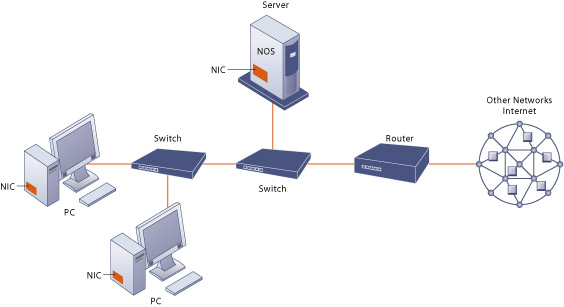 |
FIGURE 8-4 Components of a simple network
Illustrated here is a very simple network, consisting of computers, network operating system software,
cable (wiring) to connect the devices, network interface cards, switches, and a router. In this illustration,
the network operating system (NOS) resides on a dedicated server.
Most networks also contain a switch or a hub acting as a connection point between the computers. Hubs are very simple devices that connect network components, sending a packet of data to all other connected devices. A switch has more intelligence than a hub and can filter and forward data to a specified destination. Switches are used within individual networks. To communicate with another network, the network would use a device called a router. A router is a special communications processor used to route packets of data through different networks, ensuring that the message sent gets to the correct address.
Key Digital Networking Technologies
Contemporary digital networks and the Internet are based on three key technologies: client/server computing, the use of packet switching, and the development of widely used communications standards (the most important of which is Transmission Control Protocol/Internet Protocol [TCP/IP]) for linking disparate networks and computers.
CLIENT/SERVER COMPUTING
In Chapter 6, we introduce client/server computing in which client computers are connected in a network with one or more server computers. Client/server computing is a distributed computing model in which much of the processing power is located within small, inexpensive client computers under user control and resides on desktops, laptops, or in handheld devices. These powerful clients are linked to one another through a network that is controlled by a network server computer. The server sets the rules of communication for the network and provides every client with an address so it can be found by others on the network.
Client/server computing has largely replaced centralized mainframe computing in which most or all of the processing takes place on a central large mainframe computer. Client/server computing has extended computing to departments, workgroups, factory floors, and other parts of the business that could not be served by a centralized architecture. The Internet is the largest implementation of client/server computing.
PACKET SWITCHING
Packet switching is a method of slicing digital messages into parcels called packets, sending the packets along different communication paths as they become available, and then reassembling the packets once they arrive at their destinations (see Figure 8-5). Prior to the development of packet switching, computer networks used leased, dedicated telephone circuits to communicate with other computers in remote locations. In circuit-switched networks, such as the telephone system, a complete point-to-point circuit is assembled, and then communication can proceed. These dedicated circuit-switching techniques were expensive and wasted available communications capacity—the circuit was maintained regardless of whether any data were being sent.
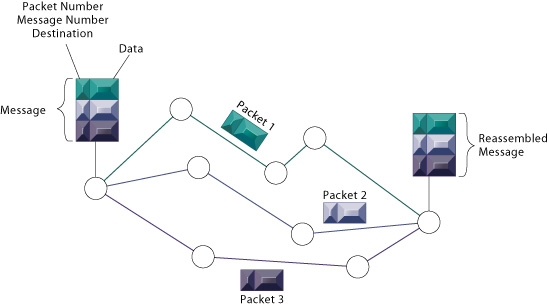 |
FIGURE 8-5 Packed-switched networks and packet communications
Data are grouped into small
packets, which are transmitted
independently over various communications
channels and
reassembled at their final
destination.
Data are gathered from many users, divided into small packets, and transmitted over available communications channels using routers. Each packet travels independently through these networks. Packets of data originating at one source can be routed through many different paths and networks before being reassembled into the original message when they reach their destinations.
Packet switching does not require a dedicated circuit but can make use of any spare capacity that is available. If some lines are disabled or too busy, the packets can be sent over any available line that eventually leads to the destination point.
TCP/IP AND CONNECTIVITY
A typical telecommunications network consists of diverse hardware and software components that need to work together to transmit information. Different components in a network can communicate with each other only by adhering to a common set of rules called protocols. A protocol is a set of rules and procedures governing transmission of information between two points in a network. In the past many diverse proprietary and incompatible protocols often forced business firms to purchase computing and communications equipment from a single vendor. But today corporate networks are increasingly using a single, common, worldwide standard called Transmission Control Protocol/Internet Protocol (TCP/IP).
TCP/IP provides a universally agreed-on method for breaking up digital messages into packets, routing them to the proper addresses, and then reassembling them into coherent messages. TCP/IP was developed during the early 1970s to support U.S. Department of Defense Advanced Research Projects Agency (DARPA) efforts to help scientists transmit data among different types of computers over long distances.
TCP/IP uses a suite of protocols, the main ones being TCP and IP. TCP refers to the Transmission Control Protocol (TCP), which handles the movement of data between computers. TCP establishes a connection between the computers, sequences the transfer of packets, and acknowledges the packets sent. IP refers to the Internet Protocol (IP), which is responsible for the delivery of packets and includes the disassembling and reassembling of packets during transmission. Figure 8-6 illustrates the four-layered Department of Defense reference model for TCP/IP.
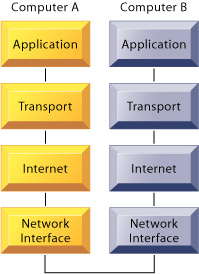 |
FIGURE 8-6 The Transmission Control Protocol/Internet Protocol (TCP/IP) reference model
This figure illustrates the four layers
of the TCP/IP reference
model for communications.
-
Application layer. Enables client application programs to access the other layers and defines the protocols that applications use to exchange data. One of these application protocols is the Hypertext Transfer Protocol (HTTP) that is used to transfer Web page files.
Transport layer. Responsible for providing the application layer with communication and packet services. This layer includes TCP and other protocols.
Internet layer. Responsible for addressing, routing, and packaging data packets called IP datagrams. The Internet Protocol (IP) is one of the protocols used in this layer.
Network interface layer. At the bottom of the reference model, the network interface layer is responsible for placing packets on and receiving them from the physical network medium, which could be any networking technology.
Open Systems Interconnect (OSI) is another network connectivity model developed by the International Standards Organization for linking different types of computers and networks. Like TCP/IP, OSI enables a computer connected to a network to communicate with any other computer on the same network or a different network, regardless of the manufacturer. OSI divides the telecommunications process into seven layers.
Physical Transmission Media
Networks can use different kinds of physical transmission media, including twisted wire, coaxial cable, fiber optics, and media for wireless transmission. Each has advantages and limitations. A wide range of speeds is possible for any given medium depending on the software and hardware configuration.
TWISTED WIRE
Twisted wire consists of strands of copper wire twisted in pairs and is the oldest electronic transmission medium. Nearly all of the telephone systems in buildings used twisted wires for analog communication, and these same wires can be used for digital communication as well.
An analog signal is represented by a continuous waveform that passes through a communications medium and has been used for voice communication. A digital signal is a discrete, rather than a continuous, waveform. It transmits data coded into two discrete states: 1 bits and 0 bits, which are represented as on–off electrical pulses. Computers use digital signals, so if one wants to use the analog telephone system to send digital data, a device called a modem is required to translate digital signals into analog form (see Figure 8-7). Modem stands for modulation/demodulation.
 |
FIGURE 8-7 Functions of the modem
A modem is a device that translates
digital signals from a computer
into analog form so that
they can be transmitted over analog
telephone lines. The modem
also is used to translate analog
signals back into digital form for
the receiving computer.
COAXIAL CABLE
Coaxial cable, similar to that used for cable television, consists of thickly insulated and shielded copper wire, which can transmit a larger volume of data than twisted wire. Cable is commonly used for local area networks because it is a faster, more interference-free transmission medium, typically operating at 10 Mbps at the desktop and 100 Mbps and 1 Gbps in network backbones.
FIBER OPTICS AND OPTICAL NETWORKS
Fiber-optic cable consists of strands of clear glass fiber, each the thickness of a human hair, which are bound into cables. Data are transformed into pulses of light, which are sent through the fiber-optic cable by a laser device at rates varying from 500 kilobits to several trillion bits per second in experimental settings. Fiber-optic cable is considerably faster, lighter, and more durable than wire media and is well suited to systems requiring transfers of large volumes of data. However, fiber-optic cable is more difficult to work with, more expensive, and harder to install.
Until recently, fiber-optic cable had been used primarily as the high-speed network backbone, whereas twisted wire and coaxial cable were used to connect the backbone to individual businesses and households. A backbone is the part of a network that handles the major traffic. It acts as the primary path for traffic flowing to or from other networks. Now, local cable companies and telephone companies are bringing fiber optic cable to homes and small businesses.
These optical networks can transmit all types of traffic—voice, data, and video—over fiber cables and provide the massive bandwidth for new types of services and software. Using optical networks, on-demand video, software downloads, and high-quality digital audio can be accessed using set-top boxes and other information appliances without severe degradation in quality or delays.
Optical networks can boost capacity by using dense wavelength division multiplexing (DWDM). Multiplexing enables a single communications channel to carry simultaneous data transmissions from multiple sources. (This can be accomplished by dividing a highspeed channel into multiple channels of slower speeds or by assigning each transmission source a very small slice of time for using a high-speed channel.) DWDM boosts transmission capacity by using many different colors of light, or different wavelengths, to carry separate streams of data over the same fiber strand at the same time. DWDM combines up to 160 wavelengths per strand and can transmit up to 6.4 terabits per second (Tbps) over a single fiber. This technology will enable communications service providers to add transmission capacity to an existing fiber-optic network without having to lay more fiberoptic cable. Before wavelength division multiplexing, optical networks could use only a single wavelength per strand.
WIRELESS TRANSMISSION
Much of the recent growth in communications and networking services is based on wireless technologies that use radio frequencies or infrared signals to send data between communications devices without using wires. Common technologies for wireless data transmission include microwave transmission, communication satellites, pagers, cellular telephones, personal digital assistants (PDAs), and smart phones. Personal computers using wireless Wi-Fi network interface cards can connect to corporate networks and the Internet in locations where a Wi-Fi transmitter has been installed. Wireless transmission has become so important to corporations that we devote the following chapter to this topic.
TRANSMISSION SPEED
The total amount of digital information that can be transmitted through any telecommunications medium is measured in bits per second (bps). One signal change, or cycle, is required to transmit one or several bits; therefore, the transmission capacity of each type of telecommunications medium is a function of its frequency. The number of cycles per second that can be sent through that medium is measured in hertz—one hertz is equal to one cycle of the medium.
The range of frequencies that can be accommodated on a particular telecommunications channel is called its bandwidth. The bandwidth is the difference between the highest and lowest frequencies that can be accommodated on a single channel. The greater the range of frequencies, the greater the bandwidth and the greater the channel’s transmission capacity. Table 8-2 compares the transmission speeds of the major types of transmissions media.
TABLE 8-2 Typical Speeds and Costs of Telecommunications Transmission Media 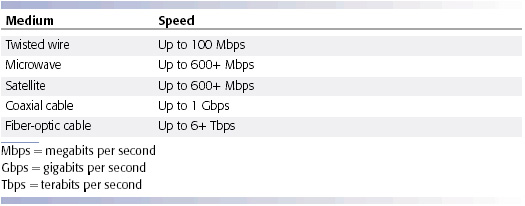 |
Types of Networks
There are many different kinds of networks and ways of classifying them. One way of looking at networks is in terms of their geographic scope (see Table 8-3).
TABLE 8-3 Types of Networks  |
LOCAL AREA NETWORKS
The first computer networks appeared in the early 1960s and consisted of display terminals linked to a mainframe computer within the same building. Researchers at Xerox Palo Alto Research Center (PARC) invented the first local area network in the early 1970s to connect desktop machines into a coherent computing facility. These networks enabled desktop machines to share printers, communicate with one another, and store files on a central desktop machine called a server.
Today most people in corporations connect to other employees and groups using local area networks. A local area network (LAN) is designed to connect personal computers and other digital devices within a half mile or 500-meter radius. LANs typically connect a few computers in a small office, all the computers in one building, or all the computers in several buildings in close proximity. LANs interconnected within multiple buildings or a geographic area such as a school campus or military base create a campus area network (CAN). LANs can link to long-distance wide area networks (WANs, described later in this section) and other networks around the world by using the Internet.
Review Figure 8-4, which could serve as a model for a small LAN that might be used in an office. One computer is a dedicated network file server, providing users with access to shared computing resources in the network, including software programs and data files. The server determines who gets access to what and in which sequence. The router connects the LAN to other networks, which could be the Internet or another corporate network, so that the LAN can exchange information with networks external to it. The most common LAN operating systems are Windows, Linux, and Novell. Each of these network operating systems supports TCP/IP as its default networking protocol.
Ethernet is the dominant LAN standard at the physical network level, specifying the physical medium to carry signals between computers, access control rules, and a standardized frame, or set of bits used to carry data over the system. Originally, Ethernet supported a data transfer rate of 10 Mbps. Newer versions, such as Fast Ethernet and Gigabit Ethernet, support data transfer rates of 100 Mbps and 1 Gbps, respectively, and are used in network backbones.
The LAN illustrated in Figure 8-4 uses a client/server architecture where the network operating system resides primarily on a single file server and the server provides much of the control and resources for the network. Alternatively, LANs may use a peer-to-peer architecture. A peer-to-peer network treats all processors equally and is used primarily in small networks with 10 or fewer users. The various computers on the network can exchange data by direct access and can share peripheral devices without going through a separate server.
In LANs using the Windows Server 2003 family of operating systems, the peer-to-peer architecture is called the workgroup network model in which a small group of computers can share resources, such as files, folders, and printers over the network without a dedicated server. The Windows domain network model, in contrast, uses a dedicated server to manage the computers in the network.
Larger LANs have many clients and multiple servers, with separate servers for specific services, such as storing and managing files and databases (file servers or database servers), managing printers (print servers), storing and managing e-mail (mail servers), or storing and managing Web pages (Web servers).
Sometimes LANs are described in terms of the way their components are connected together, or their topology. There are three major LAN topologies: star, bus, and ring (see Figure 8-8).
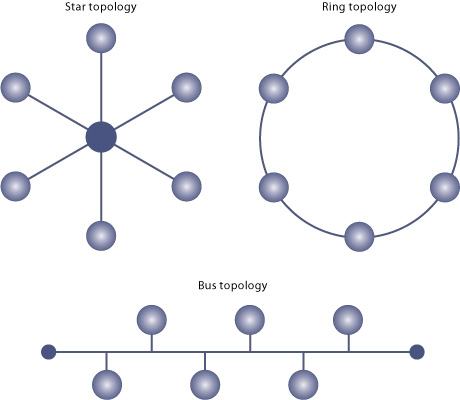 |
FIGURE 8-8 Network topologies
The three basic network topologies
are the bus, star, and ring.
In a bus topology, one station transmits signals, which travel in both directions along single transmission segment. All of the signals are broadcast in both directions to the entire network. All machines on the network receive the same signals, and software installed on the clients enables each client to listen for messages addressed specifically it. Bus networks are the most common Ethernet topology.
A ring topology connects network components in a closed loop. Messages pass from computer to computer in only one direction around the loop, and only one station at a time may transmit. Ring networks are used primarily in older LANs using Token Ring networking software.
METROPOLITAN AND WIDE AREA NETWORKS
Wide area networks (WANs) span broad geographical distances—entire regions, states, continents, or the entire globe. The most universal and powerful WAN is the Internet. Computers connect to a WAN through public networks such as the telephone system, private cable systems, or through leased lines or satellites. A metropolitan area network (MAN) is a network that spans a metropolitan area, usually a city and its major suburbs. Its geographic scope falls between a WAN and a LAN. MANs sometimes provide Internet connectivity for local area networks in a metropolitan region.
Broadband Network Services and Technologies
A number of network services and technologies are available to companies that need high-speed transmission or access to the Internet.
Frame relay is a shared network service that is faster and less expensive than packet switching and can achieve transmission speeds ranging from 56 kilobits per second (Kbps) to more than 40 Mbps. Frame relay packages data into frames similar to packets but takes advantage of higher-speed, more reliable digital circuits that require less error checking than packet switching. The major telecommunications carriers provide frame relay services. Many organizations use frame relay services in their international data communication networks.
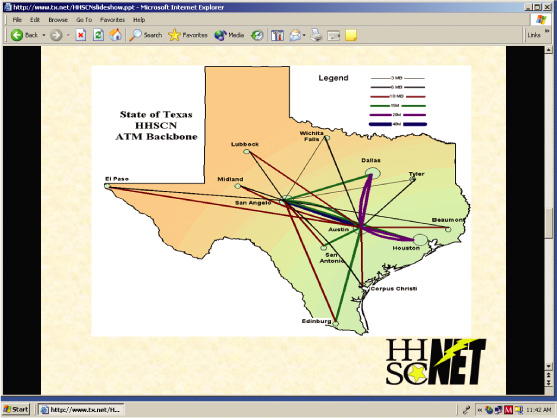 |
The Texas Health and Human
Services Consolidated Network
HHSCN) provides wide-area network
(WAN) services to Texas
state agencies and certain private
sector partners.
Integrated Services Digital Network (ISDN) is an international standard for dial-up network access that integrates voice, data, image, and video services in a single link. There are two levels of ISDN service: basic rate ISDN (which can transmit 128 Kbps) and primary rate ISDN (which can transmit at 1.5 Mbps).
ISDN is being replaced by Digital Subscriber Line (DSL). Like ISDN, Digital Subscriber Line (DSL) technologies also operate over existing copper telephone lines to carry voice, data, and video, but they have higher transmission speeds than ISDN. There are several categories of DSL. Asymmetric digital subscriber lines (ADSLs) support a transmission rate of 1.5 to 9 Mbps when receiving data and up to 640 Kbps when sending data. Symmetric digital subscriber lines (SDSLs) support the same transmission rate for sending and receiving data of up to 3Mbps.
Other high-capacity services include cable modems and T lines. Cable modems are modems designed to operate over cable TV lines. They can provide high-speed access to the Web or corporate intranets of up to 4 Mbps. However, cable modems use a shared line so that transmission slows down if there are a large number of local users sharing the cable line, although this problem can be solved by increasing the capacity of the local cable.
Firms that have large amounts of data to move across the continent, or around the world, or which have high security or guaranteed service level requirements, often lease high-speed data lines from communication providers, typically long-distance telephone companies. These lines are designated as T lines, which range from T-1 to T-4. A T-1 line offers up to twenty-four 64-Kbps channels that can support a total data transmission rate of 1.544 Mbps. Each of these 64-Kbps channels can be configured to carry voice or data traffic. A T-3 line offers delivery at 45 Mbps, and a T-4 line (although rarely used) can deliver up to 274 Gbps. Leasing a T-1 line costs about $1,000 to $2,000 per month, whereas a T-3 line costs around $10,000 to $30,000 per month. Table 8-4 summarizes these network services.
TABLE 8-4 Broadband Network Services 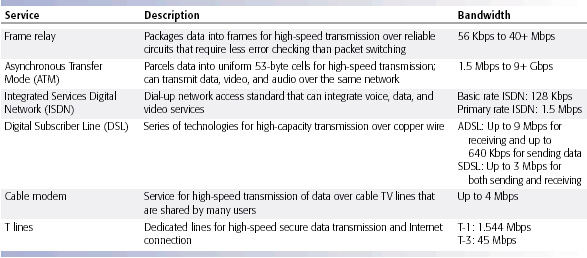 |